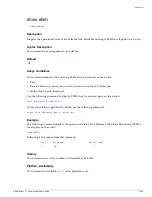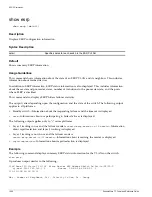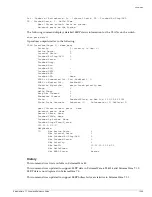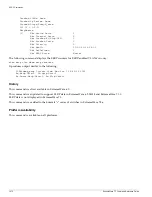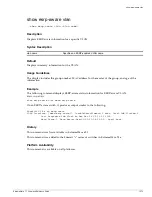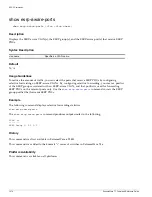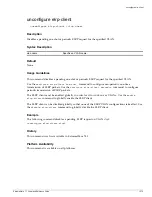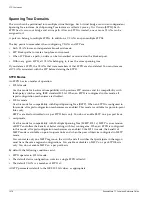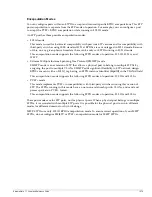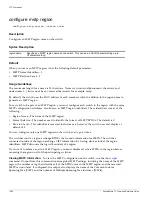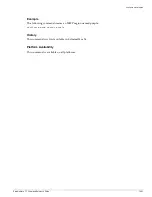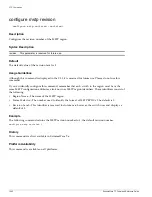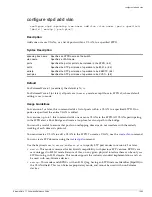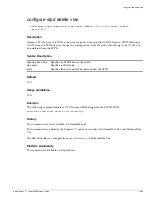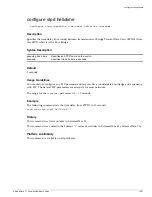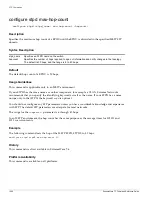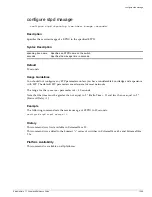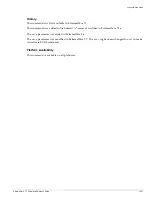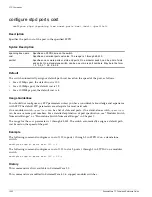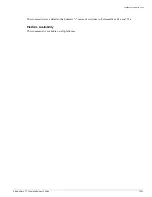
ExtremeWare 7.7 Command Reference Guide
1579
Encapsulation Modes
You can configure ports within an STPD to accept and transmit specific BPDU encapsulations. This STP
port encapsulation is separate from the STP mode of operation. For example, you can configure a port
to accept the PVST+ BPDU encapsulation while running in 802.1D mode.
An STP port has three possible encapsulation modes:
•
802.1d mode
This mode is used for backward compatibility with previous STP versions and for compatibility with
third-party switches using IEEE standard 802.1d. BPDUs are sent untagged in 802.1d mode. Because
of this, on any given physical interface there can be only
one
STPD running in 802.1d mode.
This encapsulation mode supports the following STPD modes of operation: 802.1D, 802.1w, and
MSTP.
•
Extreme Multiple Instance Spanning Tree Protocol (EMISTP) mode
EMISTP mode is an extension of STP that allows a physical port to belong to multiple STPDs by
assigning the port to multiple VLANs. EMISTP adds significant flexibility to STP network design.
BPDUs are sent with an 802.1Q tag having an STPD instance Identifier (StpdID) in the VLANid field.
This encapsulation mode supports the following STPD modes of operation: 802.1D and 802.1w.
•
PVST+ mode
This mode implements PVST+ in compatibility with third-party switches running this version of
STP. The STPDs running in this mode have a one-to-one relationship with VLANs, and send and
process packets in PVST+ format.
This encapsulation mode supports the following STPD modes of operation: 802.1D and 802.1w.
These port modes are for STP ports, not for physical ports. When a physical port belongs to multiple
STPDs, it is associated with multiple STP ports It is possible for the physical port to run in different
modes for different domains to which it belongs.
MSTP STPDs use only 802.1D BPDU encapsulation mode. To ensure correct operation of your MSTP
STPDs, do not configure EMISTP or PVST+ encapsulation mode for MSTP STPDs.
Summary of Contents for ExtremeWare 7.7
Page 60: ...60 ExtremeWare 7 7 Command Reference Guide Contents ...
Page 72: ...72 ExtremeWare 7 7 Command Reference Guide Command Reference Overview ...
Page 404: ...404 ExtremeWare 7 7 Command Reference Guide VLAN Commands ...
Page 472: ...472 ExtremeWare 7 7 Command Reference Guide QoS Commands ...
Page 492: ...492 ExtremeWare 7 7 Command Reference Guide NAT Commands ...
Page 890: ...890 ExtremeWare 7 7 Command Reference Guide Security Commands ...
Page 1130: ...1130 ExtremeWare 7 7 Command Reference Guide Security Commands ...
Page 1164: ...1164 ExtremeWare 7 7 Command Reference Guide Configuration and Image Commands ...
Page 1436: ...1436 ExtremeWare 7 7 Command Reference Guide Wireless Commands ...
Page 1490: ...1490 ExtremeWare 7 7 Command Reference Guide EAPS Commands ...
Page 1576: ...1576 ExtremeWare 7 7 Command Reference Guide ESRP Commands ...
Page 1774: ...1774 ExtremeWare 7 7 Command Reference Guide IP Unicast Commands ...
Page 1914: ...1914 ExtremeWare 7 7 Command Reference Guide IGP Commands ...
Page 2000: ...2000 ExtremeWare 7 7 Command Reference Guide BGP Commands i Series Switches Only ...
Page 2140: ...2140 ExtremeWare 7 7 Command Reference Guide IPX Commands i Series Platforms Only ...
Page 2156: ...2156 ExtremeWare 7 7 Command Reference Guide ARM Commands BlackDiamond Switch Only ...
Page 2168: ...2168 ExtremeWare 7 7 Command Reference Guide Remote Connect Commands ...
Page 2346: ...2346 ExtremeWare 7 7 Command Reference Guide PoS Commands BlackDiamond Switch Only ...
Page 2446: ...2446 ExtremeWare 7 7 Command Reference Guide LLDP Commands ...
Page 2496: ...2496 ExtremeWare 7 7 Command Reference Guide H VPLS Commands BlackDiamond Switch Only ...
Page 2620: ...2620 ExtremeWare 7 7 Command Reference Guide Index of Commands ...

